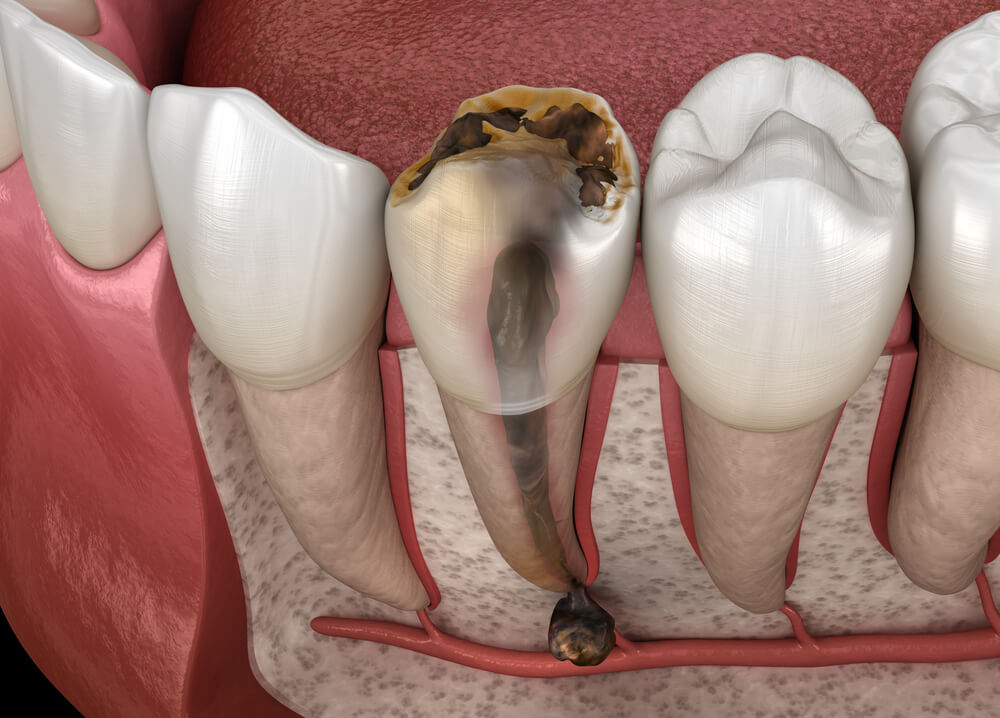Good oral care is essential for keeping your teeth healthy, but knowing how to identify potential problems early is equally important. One situation to watch for is a dead tooth because your dentist could save the tooth if you catch it early. We’ll cover everything you need to know, from what causes a tooth to die to signs of a dead tooth.
What is a Dead Tooth?
Your teeth are alive thanks to the pulp, that innermost part of the tooth that’s made of nerves, blood vessels, and connective tissue. When something damages the pulp and cuts off the blood supply to the tooth, the tooth can die. It’s important to note that it’s possible to save a “dead” tooth with proper treatment.

What Causes a Dead Tooth?
A tooth can die due to trauma or tooth decay. If you have an accident that involves a facial injury, it could cut off blood flow to your teeth. Untreated cavities that evolve to tooth decay can also result in the death of the tooth. In some cases, a large filling to treat tooth decay can traumatize the pulp enough as well.
Signs and Symptoms of a Dead Tooth
Dead tooth symptoms can vary from person to person. If you suspect you have a dead or dying tooth, watch for the most common signs and see your dentist as soon as possible.
- Discoloration of the tooth
- Tooth or gum pain
- Sensitivity to hot and cold
- Bad breath or a foul taste in the mouth
- Swelling along the gum line
What Does a Dead Tooth Look Like?
A dead or dying tooth will appear discolored. Traumatic injuries can damage the blood vessels and create a pinkish color that eventually turns grayish-black. When tooth decay causes a tooth to die, it turns yellow, gray, light brown, or black and worsens over time.
Will a Dead Tooth Fall Out?
Eventually, that’s what happens when a tooth dies, but it’s not a good idea to wait that long to seek treatment. When you have a dead nerve in your tooth and it’s no longer viable, it’s still possible to develop an infection that can spread to other teeth and your jaw.
Can You Have a Dead Wisdom Tooth?
Wisdom teeth can die like any other tooth. If the tooth came in naturally and didn’t cause you pain requiring removal, then you may not realize it’s problematic. However, if you start having discomfort or notice swelling, see a dentist as soon as possible for an exam. You may have to get those wisdom teeth out after all!
What About a Dead Baby Tooth?
If you notice discoloration of one of your child’s baby teeth, it’s possible that the tooth is dying. There’s usually no need for treatment because they tend to fall out anyway. However, you should monitor the tooth for signs of infection and take your child to a pediatric dentist for evaluation. The dentist can take x-rays to see if there are underlying issues of concern.
Dead Tooth Treatment
Your dentist has options and will know how to fix a dead tooth. They may take x-rays to determine the best course of action, but you can expect one of two outcomes.
- Extraction or removal of the tooth with a fixed bridge or implant to replace the tooth.
- Root canals can save the tooth. However, you may need several treatments to salvage the tooth, and you may require a crown to support the weakened tooth.
How to Save a Dying Tooth Naturally
Dentists prefer to save natural teeth whenever possible because nothing looks or feels quite the same. Extracting teeth can affect your ability to speak and eat, and impact your smile, especially if you have a dead front tooth. That’s why root canals remain the preferable response to a dying or dead tooth, and it’s a good idea to advocate for that option yourself.
Avoiding tooth extraction is crucial, and it’s a huge reason to visit your dentist regularly for check-ups. They may notice signs of a dying tooth early on through the exam or your x-rays. The earlier you catch it, the better your outcome.
If you have concerns about a dead or dying tooth, the team at Jefferson Dental & Orthodontics can help! Book an appointment at the office nearest you to get that tooth checked out!




